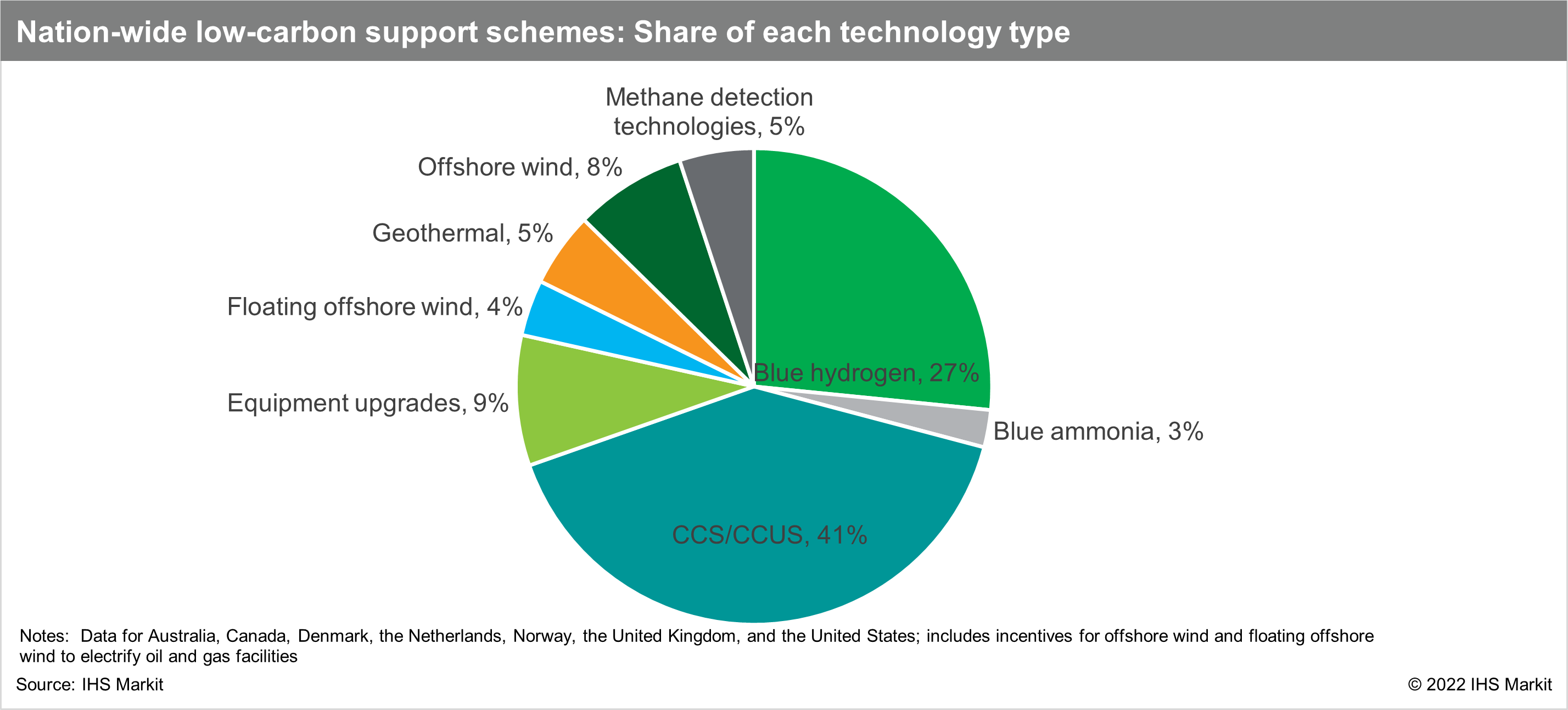[ad_1]
Oil and gas producing countries across the world are rolling out
policies and regulations to boost investment in emission-reduction
technologies and decarbonization of the of the upstream sector.
In recent years, seven diversified producers – Australia,
Canada, Denmark, Norway, the Netherlands, the United Kingdom, and
the United States – have led global efforts in establishing
regulatory frameworks to facilitate the energy transition in the
oil and gas industry. The emerging mechanisms include a mix of
support instruments from research and development (R&D) funding
to tax credits that are expected to remain important drivers of
low-carbon investment over the longer term.
Key focus on CCUS, blue hydrogen
Among large-scale commercial projects, carbon capture,
utilization, and storage (CCUS) and blue hydrogen remain a priority
area. Governments are funding CCUS R&D and pilot and
demonstration projects to encourage cost reductions, while also
partially covering the cost of commercial-scale developments
through direct financial participation or tax credits. Blue
hydrogen projects are closely related to CCUS facilities and
additional support programs are expected to be introduced over the
medium-to-longer term when more carbon storage infrastructure is in
place. The larger share of these technologies in the support scheme
mix could be also attributed to the availability of CO2 storage
capacity and natural gas resources that could be monetized via
hydrogen production.
Offshore wind and floating offshore wind used to electrify oil
and gas platforms have also enjoyed strong government backing,
particularly among the North Sea producers. In the United States,
the Biden administration is considering offshore wind leases in the
Gulf of Mexico, which could open new opportunities to decarbonize
producing platforms.

State engagement varies between regions
In North America and Australia, host governments pair budgetary
funding of research and demonstration projects with loan guarantees
and tax credits to incentivize low-carbon investment. This approach
is in line with an established policy of limited intervention in
the oil and gas industry with a focus on market mechanisms. It is
also worth noting that in addition to federal-level programs and
fiscal instruments, there are sub-national support schemes that
help create a favorable above-ground environment for low-carbon
investment. Australian states run a total of 19 initiatives to
encourage the energy transition in the oil and gas sector, while
producing provinces in Canada have 14 active incentives.

In the meantime, European host governments are more directly
involved in low-carbon projects intended to cut emissions from
upstream operations, and tax credits are not as common. In the
Netherlands and Norway, state-owned enterprises participate in CCS
projects and coordinate collaboration between different segments of
the value chain. The Norwegian government has also provided
substantial budgetary funds to the Hywind Tampen floating offshore
wind farm and the Northern Lights CCS facility. The support scheme
mix continues to evolve, particularly in the United Kingdom and
Denmark, but states are expected to remain active players in the
low-carbon segment and provide financial and operational capacity
to advance decarbonization developments.
Recent announcements signal further support to
come
In the first five months of 2022, several of these producers
have advanced policy initiatives that underscore their strong
commitment to improving the investment climate for decarbonization
projects in the oil and gas sector.
Australia
In the 2022-23 budget introduced in March, the federal
government allocated A$300 million to support low-emissions LNG,
blue hydrogen, and associated CCUS infrastructure in Darwin, a step
towards a potential future low-carbon energy hub.
With Labor winning the May 2022 elections, support for emissions
reductions is set to continue, with green hydrogen and renewables
favored, alongside expanded carbon credits. While there are likely
to be fewer new incentives for blue hydrogen and CCUS, several
incentives introduced by the previous government extend over the
coming decade, ensuring support will continue.
Canada
In early April, the federal government introduced a tax credit
for CCUS projects as part of the 2023 budget. The CCUS investment
tax credit will apply to investment in CCUS projects that
permanently store captured carbon dioxide in dedicated geological
storage or in concrete, but not for enhanced oil recovery (EOR).
The tax credit rate varies from 37.5% to 60% of investment,
depending on the type of equipment used. In addition, the
government authorized a C$2.2-billion recapitalization of the Low
Carbon Economy Fund, which finances provincial decarbonization
initiatives.
United States
In early May, the Department of Energy announced the
$2.25-billion Carbon Storage Assurance Facility Enterprise
(CarbonSAFE) Initiative, which targets site characterization and
permitting, Front End Engineering Design (FEED), and construction
of a demonstration site for the commercial storage of at least 50
million metric tons (MMt) of CO2 within a 30-year period.
Alongside the development of the supplemental methane rule by
the Environmental Protection Agency, Congress could also approve
the allocation of federal funds to support oil and gas equipment
upgrades and the installation of methane detection technologies to
mitigate emissions from upstream and midstream operations. Despite
the administration’s growing support for such incentives to balance
increased near-term production with emission-reduction goals,
multiple lawsuits against federal agencies and midterm elections
are likely to delay decisions on such support well into 2023.
United Kingdom
The Conservative government recently committed to adopt the
Energy Security Bill (likely before the end of 2022), which would
codify business models for CCUS projects. These models are expected
to provide de-risking arrangements and additional mechanisms to
support carbon storage projects.
Stable policies coupled with clear and transparent incentive
schemes are likely to be critical factors in the expansion of
decarbonization projects in the oil and gas industry. The
implementation of support programs is expected to be accompanied by
regulatory improvements that would streamline project reviews and
approvals, further bolstering the attractiveness of investment in
low-carbon developments.
***
Want to learn more about our coverage of how upstream is
transforming due to the energy transition? Try free access to the
Upstream Oil & Gas Hub to
explore selected energy research, analysis, and insights, in one
integrated platform.
ACTIVATE FREE MEMBERSHIP
Already a subscriber to our Upstream Transformation service?
Check out our new low-carbon incentives
dashboard.
***
This article was published by S&P Global Commodity Insights and not by S&P Global Ratings, which is a separately managed division of S&P Global.
[ad_2]
Source link








